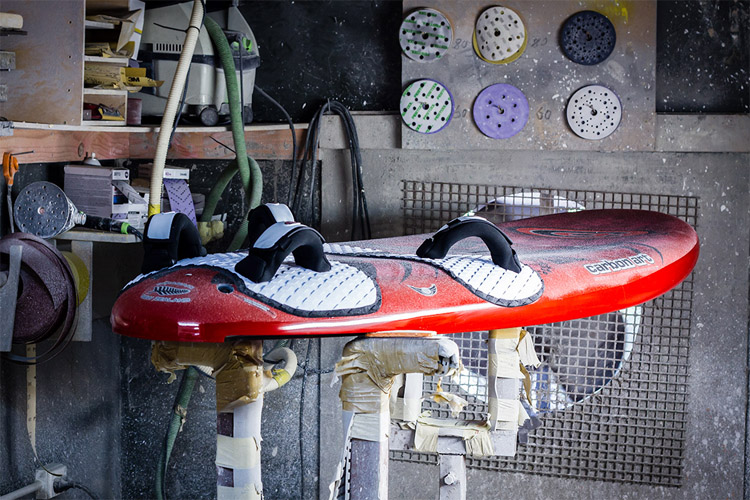The process of building a windsurf board from scratch is a lot more complicated than shaping a surfboard.
Although there are identical stages, techniques, and steps, windsurf boards feature specific parts, like the mast track and the footstraps, which require extra craftsmanship.
The windsurf board manufacturing methods and approaches vary from brand to brand, but the main stages will not differ much.
Here's how a modern windsurfing board is built:
Pre-Shaping and CNC
The first stage is designing the windsurf board. In CAD-type software, the shaper defines the template of the board and adjusts the overall look by dragging control points located near the rails, tail, and nose.
By dragging these control points in any direction, the shaper is actually changing the width, length, volume, and outline of the board.
The software allows you to compare previous versions and change the rocker curves, the bottom shape, and the behavior of the rails.
You can also specify the materials you'll use in some board areas.
In the end, you get a 3D model that depicts how the board will look like when finished. The final file is then sent to the CNC machine.
Sandwiching
Now that we've got a rough outline, it's time to wrap the EPS blank with a high-density foam skin and laminate either side of it.
The goal is to space the laminates apart to get a structure around the shape. First, you add a laminate bond, five-millimeter sheet PVC made of glass fiber, and a carbon patch that is able to handle high loads.
Then, shapers add an epoxy resin to get a better bond between the two foam surfaces.
Time for cleaning up the CNC shape blank. The board professionals shape the tack into the bottom sandwich, ensuring a good transition into the rail.
After cleaning the machine marks on the blank, it's time to put the deck sandwich on.
The deck sandwich needs to be cut to size and then darted before being wrapped around the 3D shape.
To bond it to the deck, windsurf board shapers use a mixture of glass and two different weights of carbon fiber.
In the high load areas, such as the heels and mast track areas, shapers put double layers running in multiple directions.
Then, they put a bead of glue around the entire tack edge area and insert a high-density deck block where the mast track is going to be.
Vacuuming the PCV deck sandwich takes place on a "table," which is essentially a half mold. With high pressures in the vacuum stages, you can get away with slightly less resin and, therefore, lower weight.
Reshaping and Installing Parts
The windsurf board construction process continues with grinding down the excess to get a good lap joint between the deck and bottom sandwiches.
After checking the board's measurements, it's time to mark up the extra parts and cut those in. The footstrap plugs and the deck box are made of fiber-filled nylon, and the tuttle box is made from carbon fiber and PVC foam.
In the laminating bay, shapers install the parts into the board using expanded epoxy glue. The fin box is the last thing that goes into the board.
Laminating
Lamination is the final stage of construction and provides the required stiffness and strength levels specific to each board design.
Shapers use 12K carbon fibers or S-glass fibers for guaranteed durability and toughness.
The wetting of the cloth is carried out on a special table with heating elements underneath it for proper control of the resin into the laminate.
The cloth is then placed onto the board, and a small amount of colloidal silicon resin is spread over. The laminate is trimmed, and the corners and offcuts are used as reinforcing patches to reduce waste.
Next, peel ply is placed over the board, and the board goes again into the vacuum bag and oven for the curing process at 40 degrees for six hours.
Then, it's time to prepare the overlapping areas for the best bond of the bottom laminate. A similar process used in the deck laminate is used for laminating the bottom of the board.
The exterior lamination process is concluded.
Sanding, Painting, and Finishing
Shapers add a sanding coat, but most of it gets removed when all the sanding process is finished. The professionals use several sanding tools in different directions on the board to avoid undulating surfaces.
As they move on to finer grades of paper, shapers use softer blocks and pads for gentle and smooth finishes that will only take out really fine scratches.
Sanding has two goals: to make sure the board is accurate and leaving the factory per spec, and make it look nice and shiny.
Then, shapers rub a pore fill paste over the surface of the board to fill tiny pinholes and then use a sanding epoxy primer that soaks into the pore fill and becomes one, forming a tough surface.
The board is baked for six hours at 40 degrees.
Shapers prepare the surface for the two-part acrylic urethane topcoat paint.
The bottom gets sanded again, the logo gets stenciled on, and then a clear coat urethane with Teflon additive is applied. The board is baked again.
After the polishing process, the board is opened up for the installation of the parts. Footstraps are applied, and the fin plugs are inserted.
The final stage of building a windsurf board is to apply the non-skid or texture to the deck of the board. The dust is sprinkled all over the deck, and the board is finished and ready for action.
